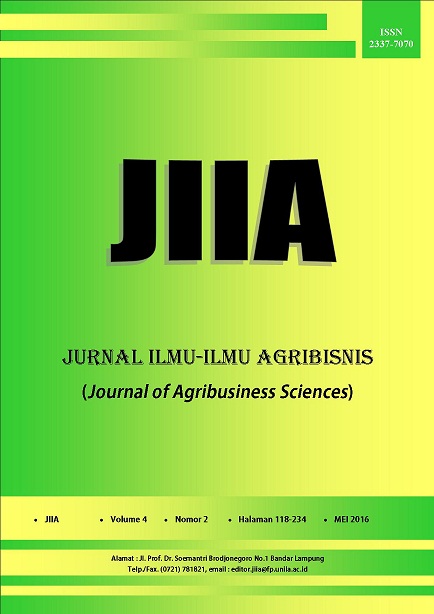FINANSIAL USAHA PENGOLAHAN BAHAN OLAH KARET (BOKAR) DI KABUPATEN TULANG BAWANG BARAT
DOI:
https://doi.org/10.23960/jiia.v4i2.1228 Abstract View: 489
Abstract View: 489
Abstract
The purposes of this research were to know the feasibility of bokar processing business. It was conducted in Mulyo Kencono Village, the Central of Tulang Bawang of Western Tulang Bawang Regency in April to June 2015. The research sample of 60 people were taken from 269 people of the population. Financial analysis was done by discount factor and compounding factor and then analyzed by four investment criteria: Net B/C, Gross B/C, NPV, and IRR. The results from the obtained analysis showed that Net B/C was1.58; Gross B/C was 1.08; NPV was Rp95,051,373.41; and IRR was 20 percent. The obtained four investment criteria showed that bokar processing was feasible to be continued. This research in line with the previous research on a nursery rubber, that the business had been done for business operators was feasible to be continued. In addition, analysis of the scale of venture was done by comparing the number of investment and total business revenues per year against business criteria scale based on UU RI No. 20 in the year of 2008 on micro business, small, and medium. Bokar processing business was a micro business with the level of investment during a period was Rp9,912,860.85 and revenue in a year was Rp33,664,813.13.
Key words: financial, marketing, rubber
Downloads
Downloads
Published
How to Cite
Issue
Section
License
Authors who publish with this journal agree to the following terms:
Authors retain copyright and grant the journal right of first publication with the work simultaneously licensed under a Creative Commons Attribution License that allows others to share the work with an acknowledgement of the work's authorship and initial publication in this journal.
Authors are able to enter into separate, additional contractual arrangements for the non-exclusive distribution of the journal's published version of the work (e.g., post it to an institutional repository or publish it in a book), with an acknowledgement of its initial publication in this journal.
Authors are permitted and encouraged to post their work online (e.g., in institutional repositories or on their website) prior to and during the submission process, as it can lead to productive exchanges, as well as earlier and greater citation of published work (See The Effect of Open Access).














